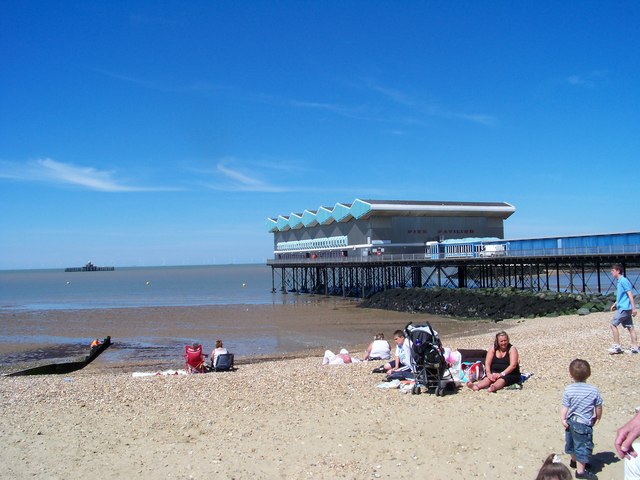The first pier opened in 1832. It was 3633 feet long and had cost £50,000. Designed officially by Thomas Telford, much of the work is credited to local carpenter Thomas Rhodes. A baggage line was added, and a sail-powered car made its maiden run on June 13th 1833.
London steamers ceased in 1862, and damage caused by toredo worm and winter storms led to closure. The pier was sold for scrap in 1871.
A new 320 foot wood and iron pier opened on August 27th 1873 to the design of Messrs. Wilkinson and Smith. It had cost £2,000. A theatre was added in 1884.
Work on extending the pier began in 1896, to plans by E.Mattheson. After a virtual rebuild (completed in 1899), Herne Bay’s ‘third’ pier measured 3787 feet. An electric tramway (used during construction work) was retained.
Herne Bay Urban District Council purchased the pier in 1909, and a Grand Pavilion opened in 1910 on a widened entrance.
World War One ended steamer services and the old tramcars were used as shelters. After the war, steamer and tram services resumed, with petrol-engine vehicles entering service on August Bank Holiday 1925. These were replaced by a battery car in 1935.
The theatre, which had been part of the second pier, had been destroyed by fire in 1928.
Trams ran for the last time on 3rd November 1939. The pier was sectioned as defence measure, but was repaired after the war. Floods in 1953 damaged the pier.
In 1968, an insurance survey found some of the supports in a critical condition, forcing closure of all except the shoreward end. The Grand Pavilion burned down in 1970.
A £900,000 sports pavilion was built and was opened on September 5th 1976 by the Rt.Hon. Edward Heath.
On 11th January 1978, storms destroyed the main neck, leaving only a short section intact. The pier-head still remains isolated out at sea.
In spring 2009 Canterbury City Council agreed to the formation of the Herne Bay Pier Trust, the main objective of which is the preservation, renovation, reconstruction and enhancement of Herne Bay Pier. Canterbury City Council does not have the funding for such a project, so it is up to independent and possibly European Funding to see this beautiful example of Victorian engineering brought back to its original glory.
Herne Bay Pier was also unusual in that the Pavilion housed the Pier Sports Centre which offered gym, dance and sports facilities and boasted a roller skating rink which, besides providing facilities for individuals and families, was the home of some of the best roller hockey teams in the country. The Pavilion was condemned in September 2010.
In February 2011, the Herne Bay Pier Trust revelaed plans to light up the old pier head using solar panels and lighting posts.
And in March 2011, the pier participated in the Party on the Pier national event starting British Tourism Week with a celebration of 100 years of roller-skating in the town featuring free skating, displays and a roller-disco. Then in April 2011, The Pier Trust opened a gallery on the seafront to promote their work.
Early 2012 saw tensions arise between the Herne Bay Pier Trust and the local council regarding both the management of the pier following the demolition of the existing pavilion and also the Trust’s plans for a new pavilion. Amid concerns that the Trust lacked the capability to stage events through the Summer period, the council increased the funding for their events team to organise things, whilst the Trust responded by putting an experienced local musician to lead their entertainment plans.
Demolition of the old pavilion was scheduled for completion by April 2012 at a cost of £750,000 and the pier was re-opened to the public in June 2012 with 2000 people attending the ceremony. The Herne Bay Pier Trust announced their plans to reclaim the pier for the people of Herne Bay. They proposed to take over the management and eventually lease or buy the pier from Canterbury City Council, raising investment for new facilities, attracting visitors and creating jobs for residents.
Then, in Novemeber 2012, the Trust revealed an ambitious plan to create a marina with 275 berths around the old pier head. It would be far enough out to sea to offer continuous berthing and would not be affected by tides. The marina would be reached by a road running along the rebuilt pier with parking for 150 cars at the end. In the short term, the Trust would create a beach hut village and restaurant on the existing platform and promote the pier for weddings.
However, by December 2012, it was revealed that the Trust’s chairman and vice-chairman had both stepped down and misgivings were beginning to surface over the £70million marina scheme, with Canterbury Council expressing doubts about the ability of the Trust to manage the pier. Also in December 2012, the Council’s engineers reported that a structural survey had found the pier to be in urgent need of major repairs with a probable cost of over £200,000.
Then in January 2013, it was revealed that a £7.50 entrance charge to the pier, plus a range of other charges, were included in the ambitious marina plans, to the consternation of the Chair of the Herne Bay Trust. Also in January, a smuggler-themed crazy golf course on the pier looked set to be given the go-ahead by the local council. By April, disagreements over the future of the pier had escalated, with Pier Trust bosses publicly distancing themselves from the group backing the marina scheme, and the resignation from the Trust of the chair of that group.
Discover more from LandmarkLocation.com
Subscribe to get the latest posts sent to your email.

